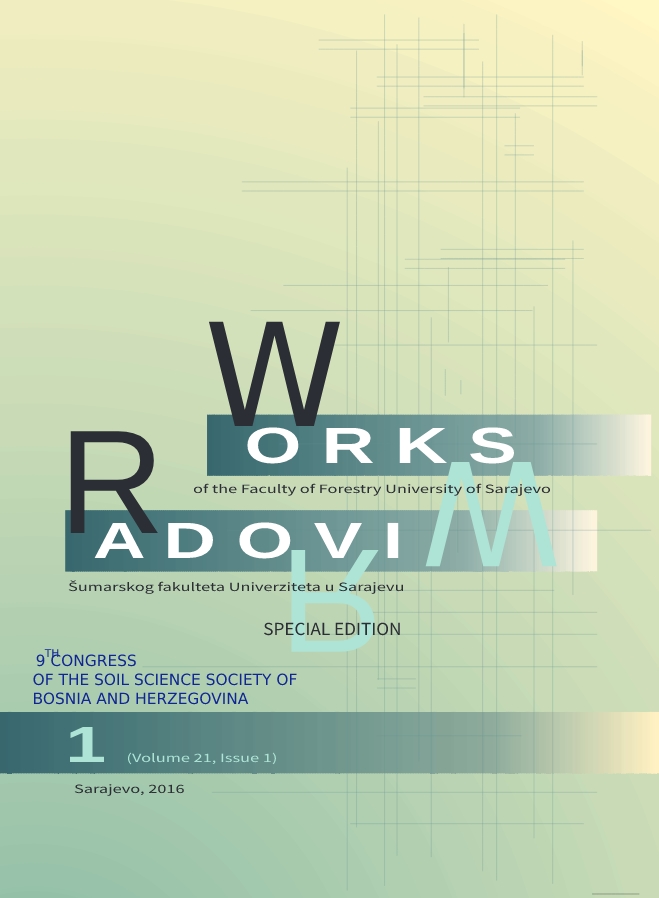THE TOTAL AND AVAILABLE CONCENTRATIONS OF ESSENTIAL TRACE ELEMENTS IN AGRICULTURAL SOILS OF EASTERN CROATIA
DOI:
https://doi.org/10.54652/rsf.2016.v1.i1.302Ključne riječi:
microelements, total concentrations, available fractionsSažetak
UDK 631.41:546.4(497.6)
The research objective was to determine the influence of basic soil chemical properties on total concentration and available fractions of essential trace elements in the soil. Agrochemical soil analysis were conducted at two localities of different soil properties Berak and Vinogradci in eastern Croatia. The soil at the site Berak was eutric cambisol of neutral reaction (pH average (H2O) 7.20), while the soil in Vinogradci was luvisol of slightly acid reaction (average pH (H2O) 5.87). Both soils were poor in organic matter and well supplied with phosphorus and potassium. As expected, at both analyzed sites the highest average concentrations were determined for total Fe, Mn and Zn followed, and the lowest concentrations were for total Cu. Higher total concentrations of analyzed microelements were recorded at the Berak site. The total concentrations of Zn and Cu in all analyzed soil samples were below the maximum permissible concentrations. The highest average concentration of available microelements fraction by EDTA Extraction, were at the Berak site determined for Mn (50.52 mg/kg), then Fe (21.77 mg/kg), Cu (4.78 mg/kg), and the lowest for Zn (1.47 mg/kg). At the Vinogradci site average concentrations of available fraction of microelements determined by EDTA extraction were the highest for Fe (77.09 mg/kg), then Mn (30.75 mg/kg), Cu (4.36 mg/kg), and the lowest for Zn (1.76 mg/kg). Identical order of average concentrations at both sites was also recorded for extraction with DTPA solution. Comparing available fraction of microelements by localities, higher average concentrations of Mn and Cu were found at the site Berak, while on site Vinogradci higher average concentrations were of Fe and Zn. At both sites the DTPA method extracted more of Fe and Mn, an average of 51.06% and 6.39% more than the EDTA method, but the method EDTA extracted more Zn and Cu, an average of 127.10% and 100.40% than DTPA method. The smallest share of the available fraction of the total concentration was recorded for Fe (0.06% by EDTA -0.09% by DTPA ), followed by Zn (1.20% by DTPA - 2.74% by EDTA) and Mn (5.93% by EDTA – 6.31% by DTPA), while the largest share was observed for Cu (10.92% by DTPA and 21.84% by EDTA).
Downloads
References
Cakmak, I. 2008. Enrichment of cereal grains with zinc: Agronomic or genetic biofortification? Plant and Soil 302:1-17.
Egner, H., Riehm, H., Domingo, W.R. 1960. Untersuchungen über die chemische Bodenanalyse als Grundlage für die Beurteilung des Nahrstoffzustandes der Boden II. Chemische Extractionsmetoden zu Phosphor- und Kaliumbestimmung. K. Lantbr. Hogsk. Annlr. W.R. 26, 199-215.
Fisher, G.E.J. 2008. Micronutrients and animal nutrition and the link between the application ofmicronutrients to crops and animal health. Turkish Journal of Agriculture and Forestry 32: 221-233.
Garcia, A., Deiorio, A.F., Barros, M., Bargiela, M., Rendina, A. 1997. Comparison of soil tests to determine micronutrients status in Argentina soils. Communications in soil science and plant analysis, 28: 19-20. 1777-1792.
Györi, Z. 2006. Effect of mineral fertilization on the Mn, Zn, Cu and Sr content of winter wheat. Cereal Research Communications, 34: 1. 461-646.
International Standard Organisation. 1994. Soil quality – Determination of pH. ISO 10390: 1994(E).
International Standard Organisation. 1995. Soil quality – Extraction of trace elements soluble in aqua regia. ISO 11466: 1995(E).
International Standard Organisation. 1998. Soil quality – Determination of organic carbon by sulfochromic oxidation. ISO 14235: 1998(E).
Jones, J.B. 2001. Laboratory guide for conducting soil tests and plant analysis. CRC Press LLC. Boca Raton. Florida. USA.
Lončarić, Z., Karalić, K., Popović, B., Rastija, D., Vukobratović, M. 2008. Total and plant available micronutrients in acidic and calcareous soils in Croatia. Cereal Research Communications. 36 (1) (S5): 331-334.
Rengel, Z. 2003. Role of plant cation/anion uptake ratio in soil acidification. In: Rengel Z (ed) handbook of soil acidity. Marcel Dekker, Inc., New York/Basel, pp 57–81.
Trierweiler, F.J., Lindsay, W,L. 1969. EDTA-ammonium carbonate soil test for Zn. ProcSoil Sci Soc Am. 33: 49-54.























